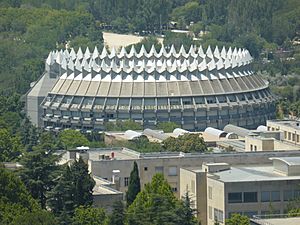Spanish Cultural Heritage Institute facts for kids
Quick facts for kids Spanish Cultural Heritage Institute |
|
|---|---|
| Native name Spanish: Instituto del Patrimonio Cultural de España |
|
 |
|
| Location | Madrid, Spain |
| Official name: Sede del Instituto del Patrimonio Cultural de España (IPCE) | |
| Type | Non-movable |
| Criteria | Monument |
| Designated | November 16, 2001 |
| Reference no. | RI-51-0010704 |
| Lua error in Module:Location_map at line 420: attempt to index field 'wikibase' (a nil value). | |
The Spanish Cultural Heritage Institute (IPCE) is a special place in Spain. It is part of the Ministry of Culture and Sports. Its main job is to find, protect, and learn about Spain's amazing history and culture.
Many experts work at the IPCE. These include architects, archaeologists, scientists, and artists. They all work together. Their goal is to keep Spain's cultural treasures safe. They also help everyone learn about them.
Contents
What the IPCE Does
The Institute has several important jobs. It helps protect Spain's cultural heritage.
- It creates and uses plans to save Spanish cultural items. These can be objects or buildings.
- It finds new ways to protect heritage. This includes new methods and ideas.
- It keeps records of all the work it does.
- It trains new experts. These people will help protect heritage in the future.
The IPCE focuses on four main things. These are protecting, researching, training, and sharing information. It works with local and regional governments. It also connects with experts and groups around the world.
How the IPCE Works
Protecting Our Heritage
One of the main jobs of the IPCE is to protect Spain's heritage. This means keeping old things safe.
The Institute works on many different projects. It protects old buildings, artworks, and ancient objects. It also cares for old books and documents.
The IPCE helps create "National Cultural Heritage Plans." These are like rulebooks for different types of cultural items. Experts from the government and other groups help write these plans.
A National Plan sets rules for how to protect, study, and share cultural heritage.
There are currently thirteen National Cultural Heritage Plans. They cover things like old cathedrals, castles, and industrial sites. They also cover old photos and how to deal with emergencies.
Learning Through Research
Research is very important for protecting heritage. Experts at the IPCE study many different areas. They look at science, architecture, and history. They also study old cultures and how to keep records.
Their research helps them understand cultural items better. This helps them decide the best ways to protect them.
Training New Experts
It is important for heritage protectors to be well-trained. The IPCE knows this. It offers many training activities. These include courses, talks, and workshops. This helps experts learn new skills. It also helps them stay updated on the best ways to protect heritage.
Keeping Records Safe
The IPCE has many old documents, books, and photos. These are very important. The Institute works to keep them safe. It also makes sure people can use them. This information helps us learn more about Spanish cultural heritage.
Sharing What We Learn
The IPCE wants to share its work with others. It shares information with the government and other groups. It also publishes books and magazines. These share scientific findings and project updates.
The Institute also organizes exhibitions. It gives tours of its building and other sites. It uses its website and social media to share information too.
IPCE Headquarters
The main building of the Spanish Cultural Heritage Institute is in Madrid, Spain. It was named a "Cultural Interest Asset" in 2001.
The building was designed in 1967. It was built between 1967 and 1970. The architects were Fernando Higueras and Antonio Miró Valverde.
See also
 In Spanish: Sede del Instituto del Patrimonio Cultural de España para niños
In Spanish: Sede del Instituto del Patrimonio Cultural de España para niños

